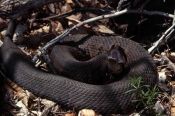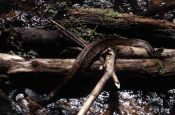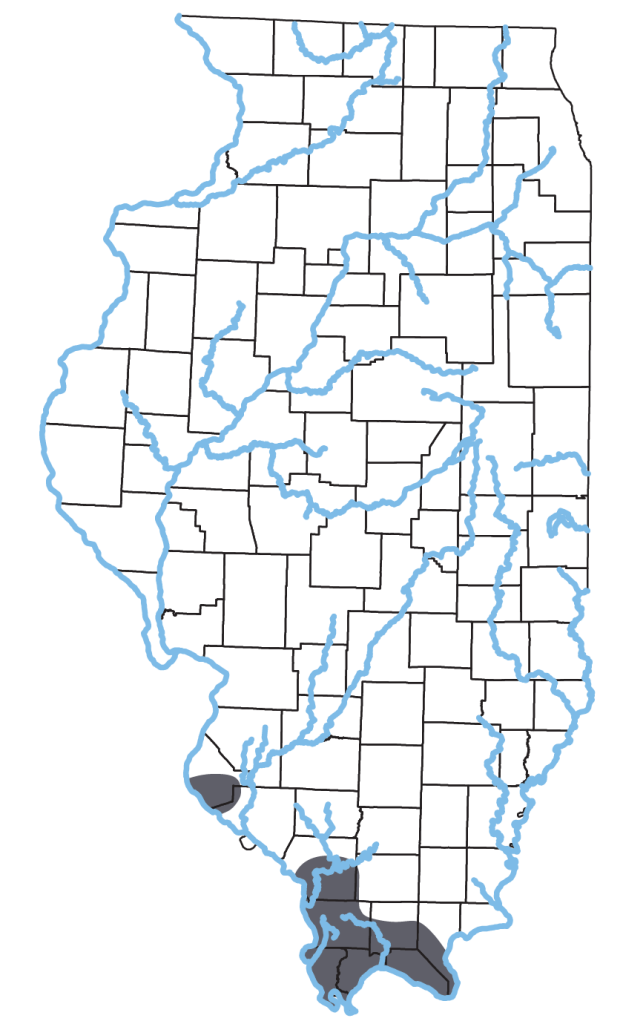Agkistrodon piscivorus (Lacapede, 1789)
VENOMOUS VENOMOUS VENOMOUS VENOMOUS VENOMOUS



Key Characters: Nine large symmetrical plates on top of head; elliptical pupil; pit between eye and nostril; back uniformly black or with ragged dark crossbands; back scales strongly keeled; anal plate not divided.
Similar Species: Copperhead, Northern Watersnake, Mississippi Green Watersnake. See the Key to Snakes of Illinois for help with identification.
Subspecies: Three subspecies are recognized: Florida Cottonmouth, A. p. conanti Gloyd, 1969; Western cottonmouth, A. p. leucostoma (Troost, 1836); and Eastern Cottonmouth, A. p. piscivorous. Only the Western Cottonmouth occurs in Illinois. However, molecular data (mtDNA) identified three independently evolving lineages that do not correspond to the traditional subspecies (Guiher and Burbrink 2008, Mol. Phylogen. Evol. 48: 112-125).
Description: Large (up to 159 cm TL), stout-bodied venomous snake. Juveniles and young adults have 12–18 dark crossbands on an olive or dark brown back and a dark stripe from snout through eye and upper lip. With age, adults become uniformly dark olive or black. Belly tan to gray and heavily marked with black. The sulfur yellow tail tip of newborn darkens with maturity.
Habitat: Cypress-tupelo swamps, sloughs, and oxbow lakes of extreme southern counties.
Natural History: Active April through October, often sunning on logs extending into water. When threatened, the mouth is opened in an exaggerated manner to expose the starkly contrasting white mouth lining. Opportunistic predators of fish, amphibians, other reptiles, and small mammals. Three to eight young born in late August or early September. Newborn 20–30 cm TL. Adults have few enemies other than human beings, but young are eaten by large fish, snapping turtles, other snakes, wading birds, and mammals.
Status: Has declined with draining and clearing of bottomland swamps and sloughs, but remains abundant in relatively undisturbed habitats.
Etymology: Agkistrodon – ankistron (Greek) meaning fishhook; piscivorous – piscis (Latin) meaning fish; voro (Latin) meaning ‘eat greedily’, devour; leucostoma – Gr. leukon white and Gr. stoma mouth.
Original Description: For piscivorous, Lacapede, B.G.E. 1789. Histoire naturelle des quadrupeds ovipares et des serpens. Academie Royal des Sciences, Paris. For leucostoma, Troost, 1836. On a new genus of serpents, and two new species of the genus Heterodon, inhabiting Tennessee. Ann. Lyc. Nat. Hist. New York 3, p. 174-190.
Type Specimen: For piscivorous, not designated; for leucostoma, Neotype, GHAS 5604
Type Locality: For piscivorous, unknown; for leucostoma “western district of Tennessee”
Original Name: For piscivorous, Crot[alus]. Piscivorous Lacapede, 1789; for leucostoma, Acontias leucostoma Troost, 1836.
Nomenclatural History: Has been relatively stable in the Illinois literature. Smith (1961) spelled it leucostomus.


